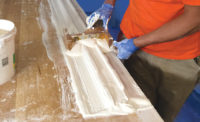Binders, that’s certainly not a term you hear every day. However, in the world of plastering, binders are very important. Really—more than any other
single ingredient—the binder will determine how the plaster will ultimately perform. As the name implies, they “bind” or glue other materials such as sand, other aggregates and fibers together and strongly influence such characteristics as permeability, compressive strength and surface hardness of the finished plaster.
Due to their importance, most plasters are named after their binder, for example a “gypsum plaster” or a “lime stucco.” In this article, we’ll give a brief introduction of the three traditional mineral binders: clay, gypsum and various limes. For thousands of years, until the middle of the 19th century, these were the only binders used for plaster in building.
Clay
Clay is not just a binder for plaster it is also the oldest material associated with construction in general. There is good reason for that. Clay is extremely abundant and easily accessible almost anywhere around the globe. Over millions of years, erosion grinds hard minerals like feldspar, granite and quartz into the mass of fine, sticky particles that we call clay. Typically, all one has to do is dig two or three feet through the topsoil to encounter thick beds of clay that is suitable for construction. It is the only binder ready to use straight out of the ground for plaster, no further manufacturing required. Clay or “earthen plasters” are easy to make, simple to apply and look beautiful.
Living in North America and Europe - where the use of concrete and cement dominates construction- you may find it hard to believe that even in the 21st century, clay is still the most used building material in the world. Adobe, rammed earth, cob, wattle and daub are all examples of raw, unfired clay based construction. And why not? Clay is both an inexpensive and practically inexhaustible resource having little to no embodied energy in its production. Furthermore, clay is the most ecologically friendly material you can imagine, boasting a completely non-toxic life cycle.
Gypsum
Gypsum is actually a “salt” of calcium that occurs naturally as a relatively soft stone. It forms in a number of ways, the most prevalent being the decomposition of limestone exposed to sulphuric acid from volcanic activity. For this reason, historically, it was also commonly referred to as “sulphate of lime.” Its properties were discovered many thousands of years ago. It’s been theorized that its use as a plaster or mortar was discovered from gypsum rocks being collected for the outer ring to contain a campfire.
Since gypsum “calcines” or changes its chemical state at a relatively low temperature, the typical heat from a campfire is more than enough to convert it into plaster. Just as we might do today, water would have been tossed on the fire the following morning when breaking camp and the calcined gypsum rocks would have fallen to powder, absorbing the excess water to form a putty. Within minutes the putty would have hardened again into solid gypsum.
No doubt some clever camper (maybe a plasterer?) found the properties of this rock potentially very useful. That hardening process was more than just rapid drying. Gypsum plasters undergo a chemical change or “set” that distinguish them from clay plasters which simply dry out. Due to these unique chemical properties, plasters made from gypsum are “self-binding,” in other words, they don’t shrink, rather, they expand a little bit when they set. This makes gypsum plasters not only excellent wall plasters but particularly useful for thick casting applications such as mouldings and ornament.
A Variety of Limes
Lime is without question one of the most versatile and enduring building materials available to mankind. Lime originates principally from the burning of limestone, the compressed accumulation of millions of years of marine skeletal remains. Similar to gypsum, it has been conjectured that the discovery of lime occurred by accident. Limestone calcines at a much higher temperature, a level of heat associated with terracotta and ceramic production. Ancient potters might have been disappointed that their limestone kilns fell apart but their plaster and mason fellows became the beneficiaries of an incredible discovery, the ability to burn and reconstitute limestone.
There are “pure” limes, composed almost entirely of calcium compounds that make beautiful white plasters perfect for everyday use, such as the “grounds” for frescoes like those of Michelangelo. Dolomitic limes are a combination of calcium and magnesium compounds that have a long history of use as mortars for masonry. Some limestones have very specific impurities that have leached into their porous structure. When burnt they form “hydraulic” limes, meaning that they “set” or harden when mixed with water. Depending on the nature of these impurities the set can be quite rapid and very hard.
A few limestones with high clay infiltration known as “marls” produce a natural cement. The Romans became experts at exploiting hydraulic limestones and marls in Celtic Gaul, modern day France, to construct aqueducts and ports. Back home they discovered that adding volcanic ash from Mount Vesuvius to pure lime would produce a similar hydraulic reaction, the famous “Roman” or pozzolanic cement responsible for the greatest unreinforced architectural work in human history, the dome of the Pantheon.
We’ll return to examine these binders in far greater detail, breaking down their chemical and physical properties as well as highlighting practical plaster applications. However, in my next article, we’re going to take a closer look at what these minerals are binding together: aggregates and fibers.







Report Abusive Comment